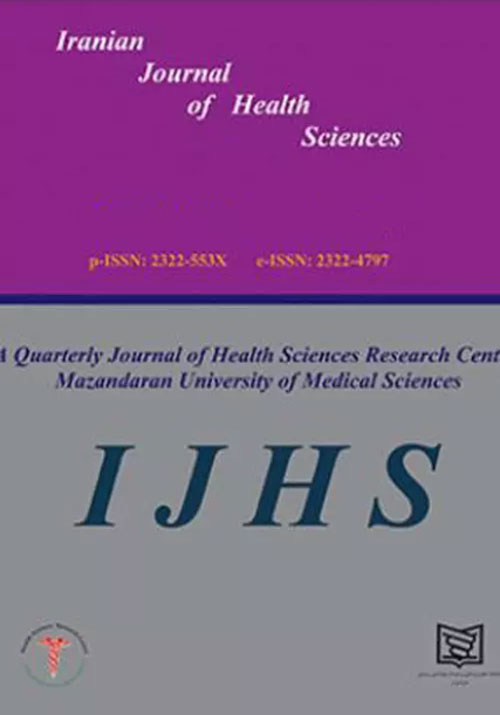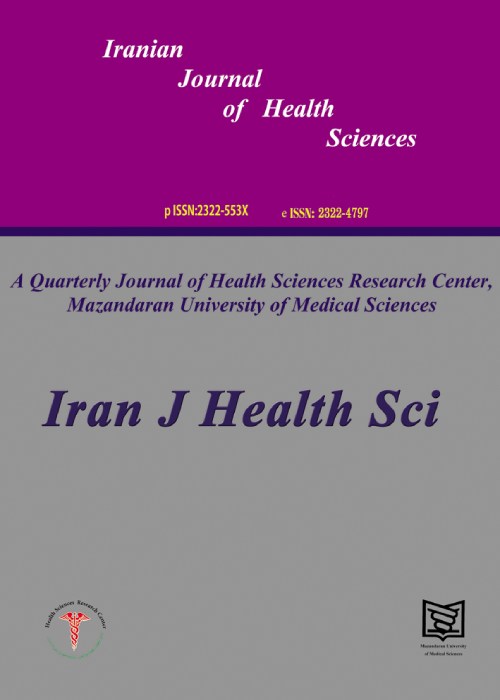فهرست مطالب

Iranian Journal of Health Sciences
Volume:10 Issue: 2, Spring 2022
- تاریخ انتشار: 1401/03/22
- تعداد عناوین: 5
-
-
Pages 1-13Background and Purpose
Violence against reproductive age women harms other health prioritiesو such as family planning and maternal health. This study aimed to identify the determinants of violence among reproductive age women.
Materials and MethodsThis cross-sectional study was conducted among 182 married women, 15-49 years old in Sarab City, Iran, through simple random sampling in 2018. Data were collected by a self-designed questionnaire including demographic characteristics, physical, psychological, verbal, economic, and sexual violence. Then, it was analyzed using an independent samples t-test, one-way ANOVA, Pearson Correlation, and multivariate linear regression.
ResultsThe prevalence of physical, psychological, sexual, economic and verbal violence in women was11 (6%), 14(7.7%), 18(9.9%), 24(13.2%), and 37(20.3%), respectively. Husband's older age and husband's older age of marriage increased (B=0.14, 95% CI= 0.00 to 0.28) and decreased (B= -1.17, CI= -0.27 to -0.06) verbal violence against women. Illiteracy in spouses reduced physical violence (B=-2.43, CI= -4.58 to -0.27) and sexual violence (B= -1.62, CI= -3.08 to -0.16) and in women, it reduced psychological violence (B=-2.63, CI= -4.81 to -0.45). Spousal smoking reduced physical (B= -0.97, CI= -1.78 to -0.17), psychological (B= -1.17, CI= -2.01 to -0.33), and verbal (B= -1.22, CI= - 1.96 to -0.48) violence; however, women's alcoholism (B= 7.31, CI= 0.27 to 4.43) and having children from a previous marriage of the woman (B= 0.06, CI=0.04 to 1.16) increased physical violence. The highest economic violence was seen in female employees (B= 1.31, CI=0.35 to 2.27). Psychological (B= -4.92, CI= -7.89 to -1.49) and sexual (B= -2.16, CI= - 4.09 to -0.22) violence was less experienced in men's second marriage.
ConclusionConsidering the high prevalence of verbal violence and related factors, conducting the necessary screenings to recognize it in time, teaching communication skills and anger management to husbands seems essential.
Keywords: Violence, Risk Factors, Determinant, Women, Fertility, Reproductive -
Pages 14-28Background and purpose
Machine learning is a class of modern and strong tools that can solve many important problems that nowadays humans may be faced with. Support vector regression (SVR) is a way to build a regression model which is an incredible member of the machine learning family. SVR has been proven to be an effective tool in real-value function estimation. As a supervised-learning approach, SVR trains using a symmetrical loss function, which equally penalizes high and low misestimates. Recently, high-dimensional datasets are the most challenging problem that may be faced. The main problems in high-dimensional data are the estimation of the coefficients and interpretation. In the high-dimension problems, classical methods are not applicable because of a large number of predictor variables. SVR is an excellent alternative method to analyze such datasets. One of the main advantages of SVR is that its computational complexity does not depend on the dimensionality of the input space. Additionally, it has excellent generalization capability, with high prediction accuracy.
MethodsSVR is one of the best methods to analyze high-dimensional datasets. It is a really reliable and robust approach to have a good fit with high accuracy. SVR uses the same principles as the support vector machine for classification, with only a few minor differences.
ResultsThe techniques for analyzing the high-dimension datasets are really important methods because we frequently face such datasets in medical science and gene expression. It is not easy to analyze the high-dimension datasets because the classic methods cannot be used to estimate and interpret them. Therefore, we have to use alternative methods to analyze them. SVR is one of the best methods that can be applied. In this research, SVR is used in a real high-dimension dataset about the gene expression in eye disease, and then it is compared with well-knownmethods LASSO and Sparse least trimmed squared (sparse LTS) methods. Based on the numerical result, SVR and Sparse LTS were better than LASSO, since the real dataset contained outliers (bad observation with big residuals).
ConclusionsSVR method was the best method to model and predict the high-dimensional mammalian eye dataset, because it was not affected by the outliers' corruptive impact, and it has minimum MSE (mean squares error), MAE (mean absolute error) and RMSE (root mean squared error) fitting criteria in comparison with the classical methods such as LASSO and sparse LTS estimations. Thus, sparse LTS was found to act better than the LASSO method. Moreover, stabilization of the data and freedom from obtaining the regularization parameter by running a complicated algorithmic program, which decreased the computational costs dramatically, were the invaluable advantages of this technique in comparison with the classical methods.
Keywords: High-dimensional data set, Ordinary least square method, Outliers, Robust regression -
Pages 29-39Background and purpose
Recent research suggests that obese people are up to 80 times more likely to develop type 2 diabetes than those with a normal BMI. Besides, obesity, inadequate physical activity, and unhealthy diets are the main causes of this metabolic disease. The purpose of this study was to investigate the effect of six weeks of high-intensity interval training on muscle expression of Fat mass and obesity-associated protein (FTO) and Peroxisome proliferator activator receptor gamma (PPAR-γ) in obese diabetic rats.
Material and methodsThis experimental study was carried out on 12 male Wistar rats (220±20 g bodyweight and 10 weeks old). Animals received a high-fat diet within six weeks, and then in order to induce type 2 diabetes, an intraperitoneal injection of a single dose of 30 mg/kg freshly prepared streptozotocin (STZ) (Sigma, USA) solved in citrate buffer (pH 4.5) was performed. Diabetic rats were divided into two (High-Intensity Interval Training and control) groups randomly. HIIT program included five sessions of 30 minutes per week. 48 hours after the last training session, the outcomes were measured. The muscle expression of FTO and PPAR-γ was measured using the real-time PCR method. Independent samples t-test and Analysis of covariance (ANCOVA) were applied to compare the means.
ResultsThe expression of FTO (P<0.01), fasting blood sugar (P<0.001), weight (P<0.001) and HOMA-IR (P<0.004) significantly decreased after six weeks of high-intensity interval training, whilst PPAR-γ expression (P<0.007) significantly increased.
ConclusionRegarding the results of this study, it can be stated that a six-week HIIT program can improve glucose metabolism and insulin sensitivity. It can also increase the expression of diabetes- and obesity-associated genes (e.g., PPAR-γ and FTO), and thereby plays a prominent role in the control and treatment of type 2 diabetes in obese patients.
Keywords: Aerobic, Exercise, Insulin, Type 2 diabetes, Glucose -
Pages 40-47Background
Work-related accidents are those events that occur while on duty in the workplace. Due to the lack of accurate information about the epidemiological status of occupational injuries in Isfahan, the present study was conducted to investigate the epidemiology of workplace accidents.
MethodsThis was a retrospective cross-sectional study assessing the medical records of all patients injured in the workplace in 2018. The list of all work accident patients was collected from the Hospital archives that accounted for 836 cases. The information about age, sex, the season in which the accident has occurred; type of insurance, nationality, marital status, occupation, and the type of injury were extracted. Afterward, they were statistically analyzed using qualitative variables as well as Chi-square or independent t-test. A P-value of less than 0.05 was considered significant.
ResultsBased on the findings, the 836 assessed cases had the mean age of 34.43±12.73 years old and were predominantly males (n=812, 97.2%). They were mostly bachelor (n=462, 55.26%) and aged less than 40 years old (57.4%). Soft tissue injuries (53.94%), amputation (13.63%), upper (13.27%) and lower (7.77%) extremities fractures ranked the highest types of injuries. 342 (40.9%) of the cases did not have any insurance, while Social security insurance (48.3%) was the most common one among the supported workers with insurances.
ConclusionAccording to the present study, the highest number of hospitalizations due to workplace injuries were related to less than 40 years old young adults who were mostly bachelor, experienced soft tissue injuries. Most of the patients were under Social security insurance coverage, while the significant rate of 40% without any insurance surprised us. The results are consistent with the previous studies. Further investigations with more precise assessments are strongly recommended.
Keywords: Workplace Injuries, Work Accidents, Epidemiology -
Pages 48-57Background and purpose
Research has shown that aging affects appetite and energy intake. The aim of this study was to investigate the protective effect of aerobic training (AT) and spirulina (SP) on Nesfatin-1 and Peptide YY (PYY) in overweight elderly men.
Materials and MethodsIn this clinical trial study, 32 overweight elderly men (age 57.50±4.84 years, Body mass index: BMI 26.90±2.85 kg/m2) in public and administrative centers of Bandar-e-Anzali were selected and randomly divided into four groups including Overweight (OW), Overweight-Aerobic Training (OWAT), Overweight-Spirulina (OWSP), and Overweight-Aerobic Training -Spirulina (OWATSP). AT, including running on treadmill was performed three sessions per week with intensity of 70 - 85% of maximum heart rate for eight weeks. The groups of OWSP and OWATSP were provided two 500 mg SP tablets daily in the morning and evening. Serum Nesfatin-1 and PYY levels were measured using the kit and ELISA method. Data were tested using independent samples t-test and ANCOVA at a significance level of p <0.05
ResultsMean weight and BMI in the groups of aerobic exercise, spirulina and exercise- spirulina decreased significantly (P<0.05). The results showed that exercise, spirulina and exercise-spirulina caused a significant increase in Nesfatin-1 and Peptide YY compared to the pretest and control group (P=0.001). Also, the Nesfatin-1 and Peptide YY level of the exercise- spirulina group was significantly higher than the spirulina group (P=0.003).
ConclusionAT intervention and daily intake of SP supplement were associated with increase in hormones affecting appetite. It was then recommended that overweight and obese elderly people use this effective combination strategy for its benefits.
Keywords: Aging, Overweight, Exercise, Spirulina, Nesfatin-1, Peptide YY


